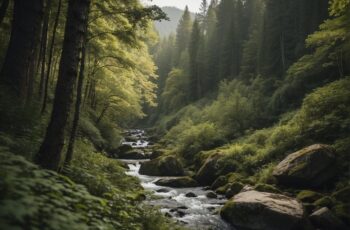Mushroom hunting can be a rewarding pursuit, connecting you with nature and providing the satisfaction of foraging your own food. To ensure your efforts are fruitful, understanding when to venture into the wild is key. Mushrooms thrive under certain conditions, and timing your hunts with these conditions significantly increases your chances of a bountiful harvest.
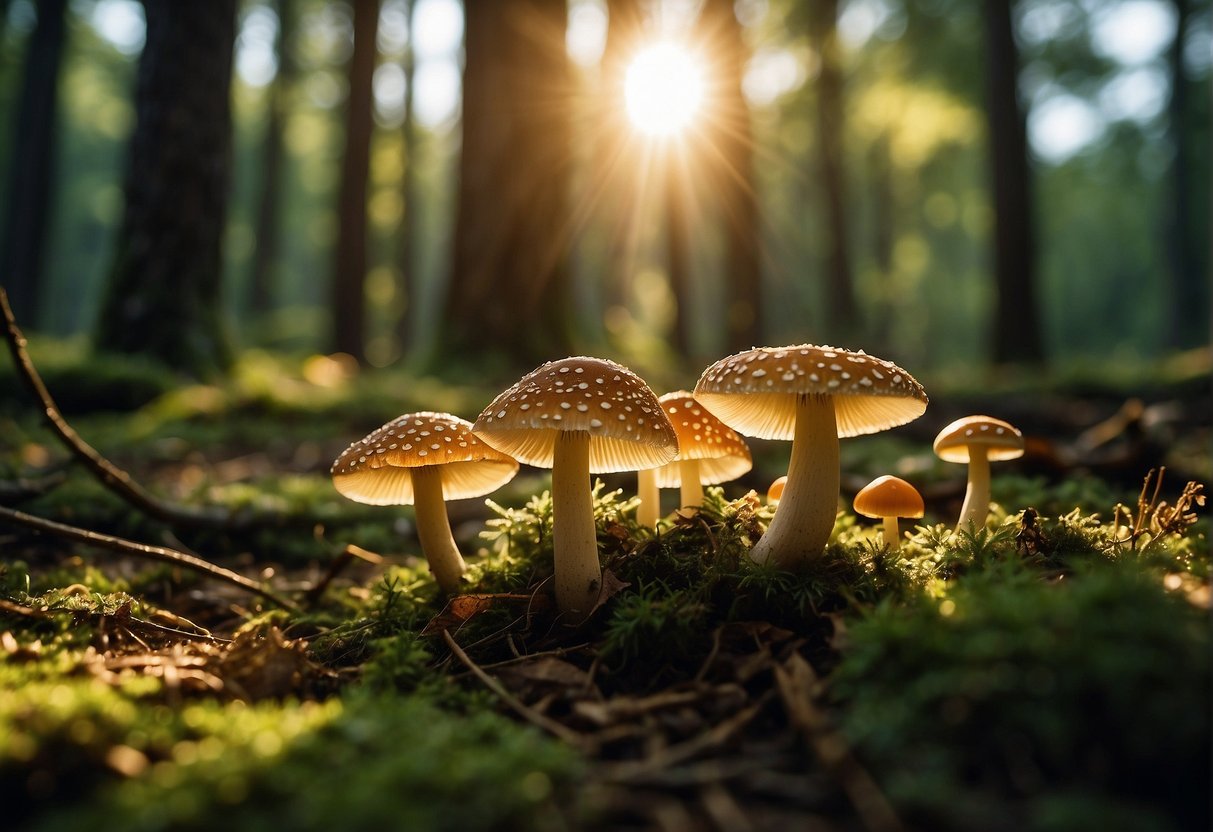
Weather plays a pivotal role in mushroom growth, with factors like temperature, moisture, and season dramatically affecting the availability of different species. Certain mushrooms flourish post-rainfall or when humidity is high, while others depend on specific temperature ranges. By keeping a close watch on local weather patterns and understanding the cycles of your targeted mushrooms, you can maximize your harvest.
Key Takeaways
- Ideal mushroom hunting times vary with weather and fungal species.
- Moist conditions and moderate temperatures often signal a good time to hunt.
- Seasonal knowledge and weather trends help pinpoint the best hunting opportunities.
Understanding Mushroom Biology and Varieties
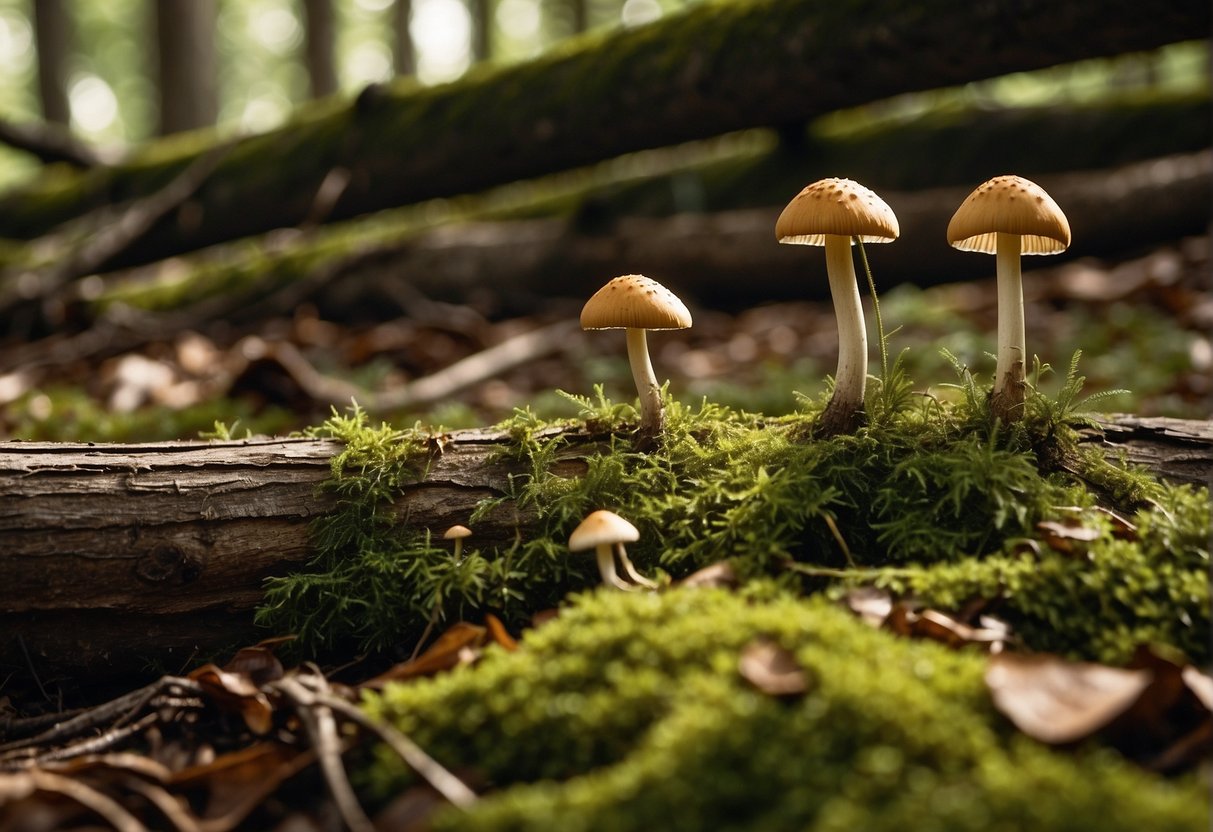
When it comes to mushroom hunting, recognizing the various mushroom species and understanding their life cycles are essential for both safety and success. Let’s dive into the specifics.
Mushroom Life Cycle and Spores
Mushroom reproduction is a fascinating process that revolves around spores. Unlike seeds from plants, spores are microscopic and can number in the billions. A single mushroom will release these tiny spores into the air to colonize new habitats. When conditions are ripe—often in damp, humid environments—these spores germinate and form a network of cells called mycelium. This mycelium can remain dormant for months, only producing a fruiting body, what you recognize as a mushroom, when conditions are right.
Edible Varieties to Look For:
- Morels: Sponge-like appearance, highly sought after.
- Chanterelles: Vibrant yellow-orange, with a unique, vase-shaped body.
- Oyster mushrooms: Resemble oysters, growing in a shelf-like formation on wood.
- Porcini: Hearty, with a thick stem and brownish cap.
- Chicken-of-the-woods: Bright orange, fan-shaped, tastes like chicken.
Identification of Edible Mushrooms
Successful mushroom hunters not only need keen eyes but also knowledge about the distinctive features of edible mushrooms. Here’s what to look for:
- Cap Shape: Morels have a distinct, honeycomb-like cap, different from poisonous false morels.
- Color: Chanterelles boast a golden hue, unlike any inedible species.
- Gills: Oyster mushrooms have gills running down their stems, a key identification point.
- Habitat: Chicken-of-the-woods thrive on dead logs, as do many edible mushrooms.
Poisonous Mushroom Varieties
Caution is your best friend while foraging: some poisonous mushrooms closely resemble the edible ones.
Beware of These Lookalikes:
- False Morels: Contain hydrazine toxins, which can be fatal.
- Jack O’Lantern: Resemble chanterelles but are highly toxic and bioluminescent.
- Deadly Galerina: A deadly look-alike of some oyster mushrooms.
Understanding these differences can mean the difference between a delightful meal and a dangerous mistake. Remember, if you’re ever unsure about a mushroom’s identification, it’s better to leave it be.
Optimal Conditions for Mushroom Growth
To successfully hunt mushrooms, you need to be aware of the specific environmental conditions they thrive in. Your awareness of soil characteristics, temperature, moisture levels, and other climatic factors will significantly increase your chances of a bountiful forage.
Soil and Temperature Factors
Mushrooms prefer certain soil temperatures to trigger their growth. Most wild fungi, like the highly sought-after morels, tend to emerge when the soil temperature at about 4 inches deep reaches approximately 50-60°F (10-15.5°C). It’s essential to monitor southward and westward facing slopes as they warm up more quickly in the spring, creating an ideal habitat for early-season mushrooms.
Moisture, Rainfall, and Humidity
A consistent level of moisture is crucial for mushroom development. Typically, mushrooms need damp environments to prosper. Heavy rainfall, especially following a dry period, can stimulate a surge in mushroom growth. Higher humidity in the air, often found in forested areas, encourages this growth further. It’s the combination of sufficient rainfall and humidity that sets the stage for mushrooms to proliferate, so planning your foraging after these conditions can be particularly rewarding.
Best Locations for Mushroom Hunting
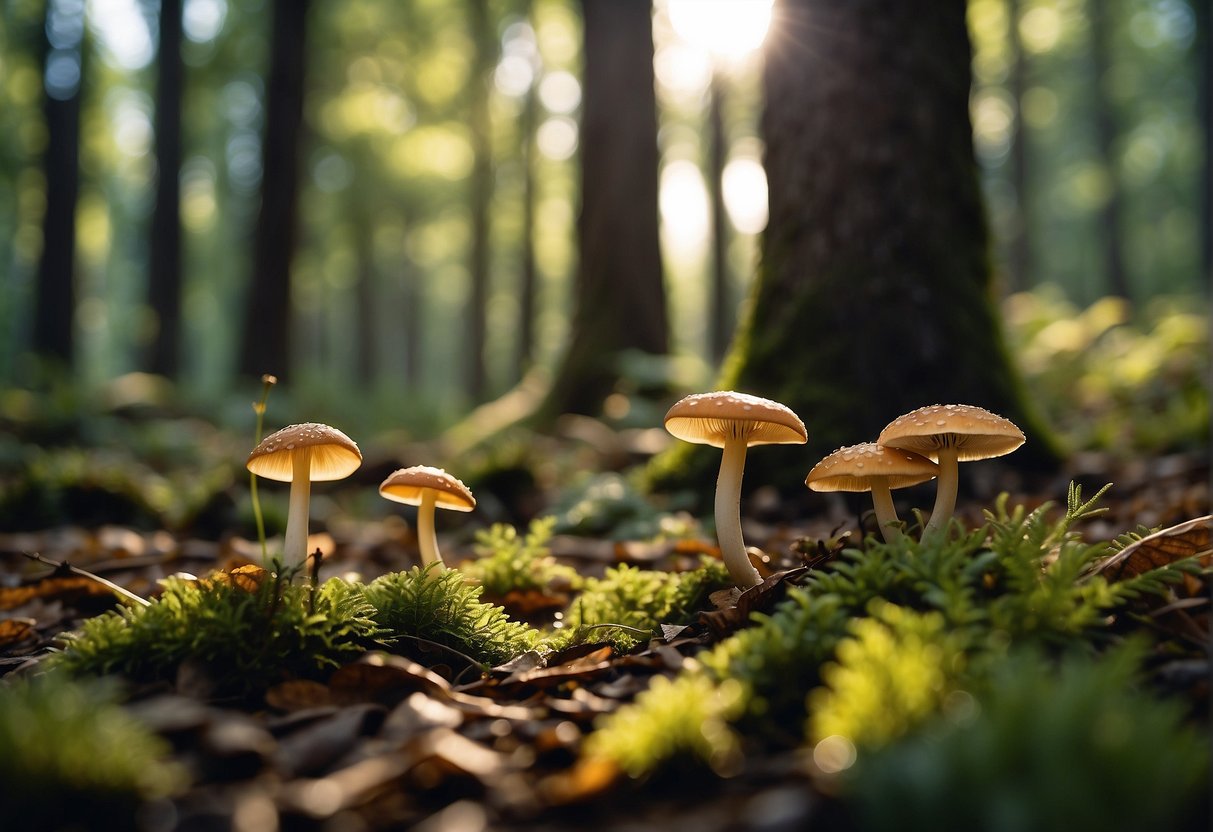
In pursuit of the finest wild mushrooms, your focus should be on specific forest types known for their symbiotic tree associations, as well as understanding the intricacies of land ownership to ensure accessibility.
Forest Types and Tree Associations
Hardwood Forests: Your best bet for bountiful mushroom forays are in hardwood forests where trees like oak, ash, and elm create a hospitable environment for many mushroom species. Apple orchards could also be a surprising yet abundant source, particularly in the fall season.
Conifer-rich areas: Though different from hardwoods, forests dominated by conifers can also be rewarding, especially when searching for varieties that prefer the acidic soil these trees create.
Understanding Land Ownership and Accessibility
Public Lands: Tap into the resources of the North American Mycological Association for guidance on public lands where mushroom hunting is permitted. Remember, some areas may require permits or have specific regulations.
Private Land: Seeking permission to hunt mushrooms on private property can unlock less trafficked and potentially richer picking grounds.
Burn Sites: Keep an eye on burn sites on public or private land; these areas can sometimes yield an unexpected harvest of mushrooms, particularly morels, in the seasons following a fire.
By keying into these locations and adhering to best practices, your mushroom hunting expeditions on the forest floor of forested areas are bound to be fruitful.
Mushroom Hunting Techniques and Tips
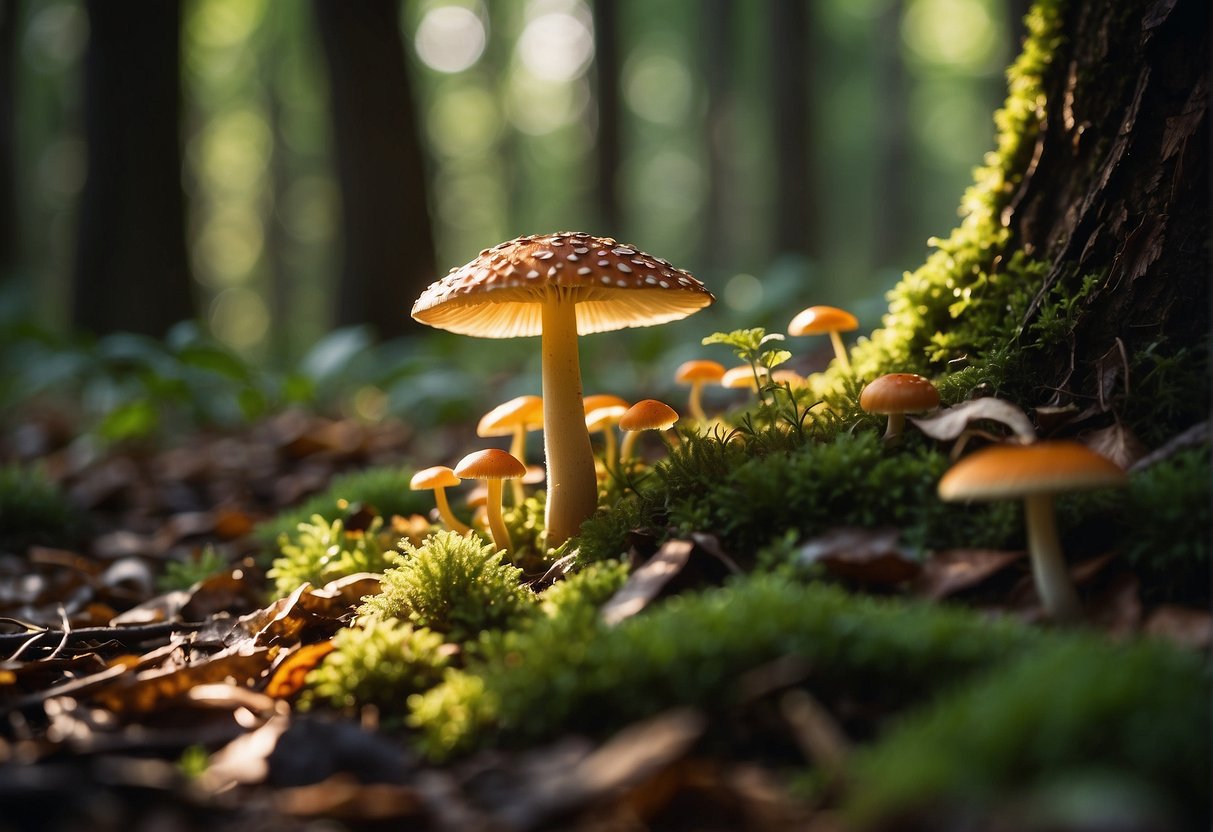
Mastering the art of mushroom hunting is not just about wandering through the woods and hoping for the best. It’s about knowing where to look, what to bring, and how to harvest mushrooms responsibly. The techniques and tips provided here will give you the confidence to embark on your mushroom adventures with greater success.
Effective Searching Strategies
When you’re on the hunt for mushrooms, such as the elusive morel, understanding their habitat is crucial. Morels thrive in moist, wooded areas, often near decaying trees. Keep an eye on the hunting season, which typically peaks in spring. For better guidance, tree identification skills can be invaluable, as certain mushrooms grow near specific trees. Don’t just look on the ground; pay attention to patterns like spore prints and changes in the landscape, which topographic maps can help you navigate.
- Shed Hunting: Morels often grow in areas where trees have shed their leaves or where there’s fallen timber.
- Foraging Hotspots: Seek locations with high moisture, such as near creeks or in damp lowlands.
Equipment Essentials
Proper gear can make your mushroom hunting much more effective and enjoyable. Always bring a basket to hold your finds; this allows spore dispersal, contributing to future mushroom growth. A sharp knife is essential for cleanly cutting mushroom stems. For organization, mesh bags can separate different types of mushrooms. Don’t forget a GPS or a guidebook with topographic maps to stay oriented and safe in the woods.
- GPS Device: Keep track of your location and easily find your way back.
- Foraging Gear:
- Basket: For collection and spore dispersal.
- Knife: For clean cutting stems.
- Mesh Bags: To separate mushroom varieties.
- Guidebook: For mushroom identification and safety tips.
Safety and Sustainability Practices
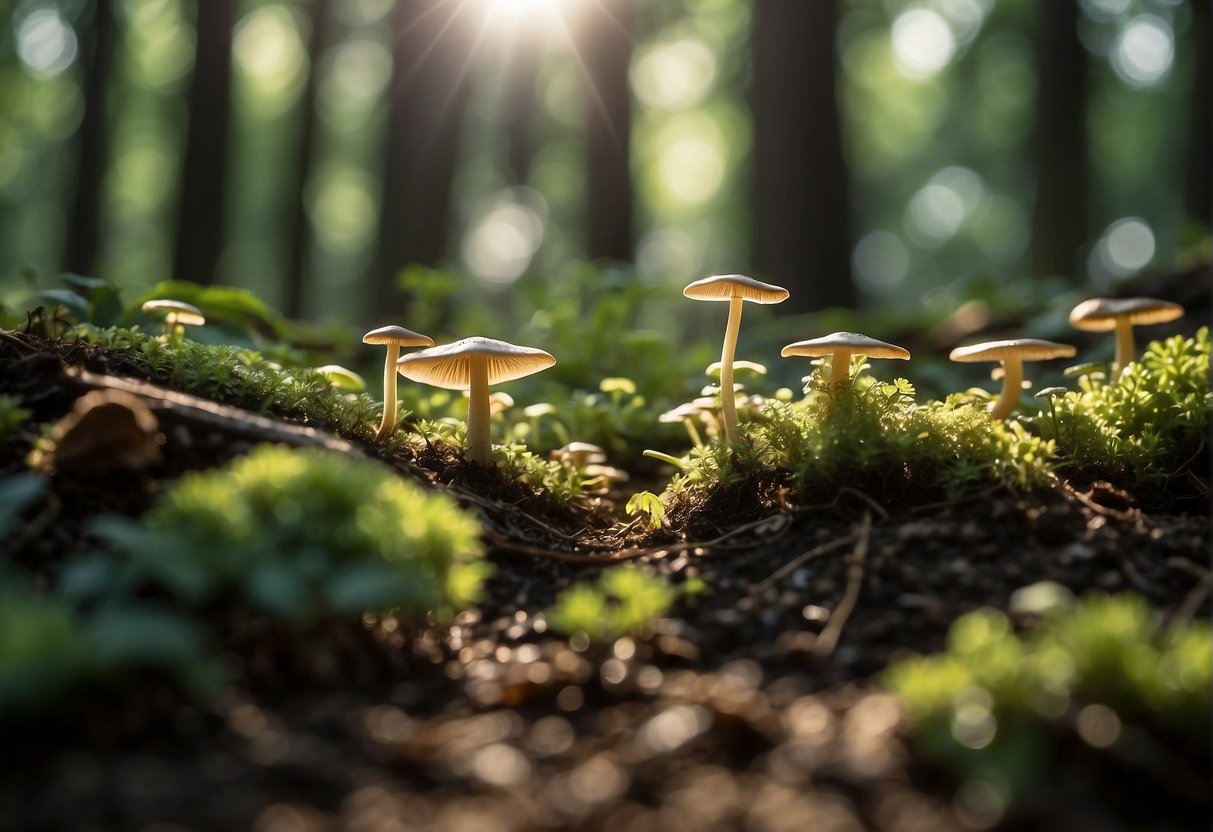
When you’re out in the wilds of New York or any other bountiful region, safety and respect for nature should always be your guides. Engaging in mushroom hunting requires preparedness and knowledge to ensure both your well-being and the conservation of natural habitats.
Precautions Against Poisonous Varieties
Identify with certainty: Before you begin your mushroom hunt, educate yourself thoroughly on the characteristics of both edible and poisonous mushrooms. For instance, some mushrooms, as described by Paul Stamets, offer nourishment or profound experiences, while others can be harmful or lethal.
- Utilize reputable guidebooks or digital resources specific to your region.
- Consider joining a local foraging club or taking part in workshops.
Check weather conditions: Specific weather patterns in New York can affect mushroom proliferation. A period of rain following a dry spell can create ideal conditions for mushroom growth.
- Persistent, damp environments are prime for mushroom emergence.
- Arm yourself with a weather app or check the forecast regularly to plan your excursions after suitable weather events.
Ethical Foraging and Conservation
Harvest responsibly: It’s crucial to practice sustainable mushroom foraging. When you’re out in the forest, remember that sustainability is key to ensuring that mushrooms continue to thrive for years to come.
- Only take what you need to prevent wastefulness and allow for continued growth.
- Avoid raking the ground as it damages the mycelium and future mushroom populations.
Tread lightly: The principles of Leave No Trace apply to mushroom hunting as well. Be mindful of your impact on the ecosystems you visit.
- Stick to established trails to minimize your environmental footprint.
- Leave the habitat as undisturbed as possible to maintain the natural balance.
Keep these pointers in mind, respect the natural order, and you can enjoy a fruitful and responsible mushroom foraging adventure.


